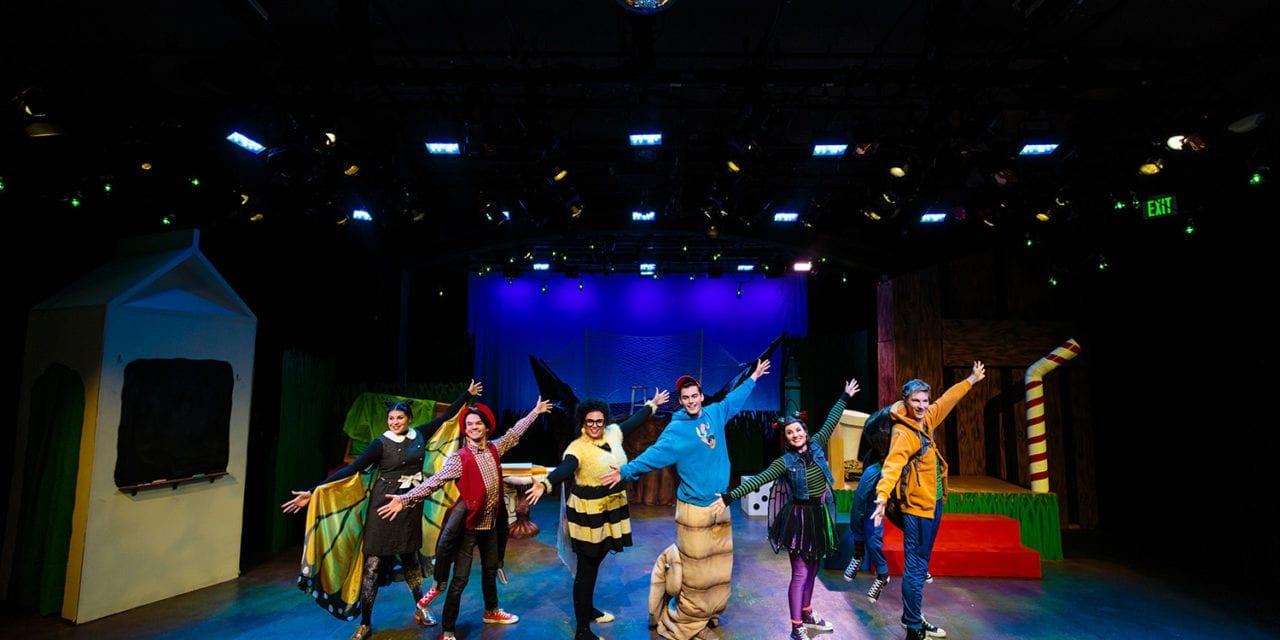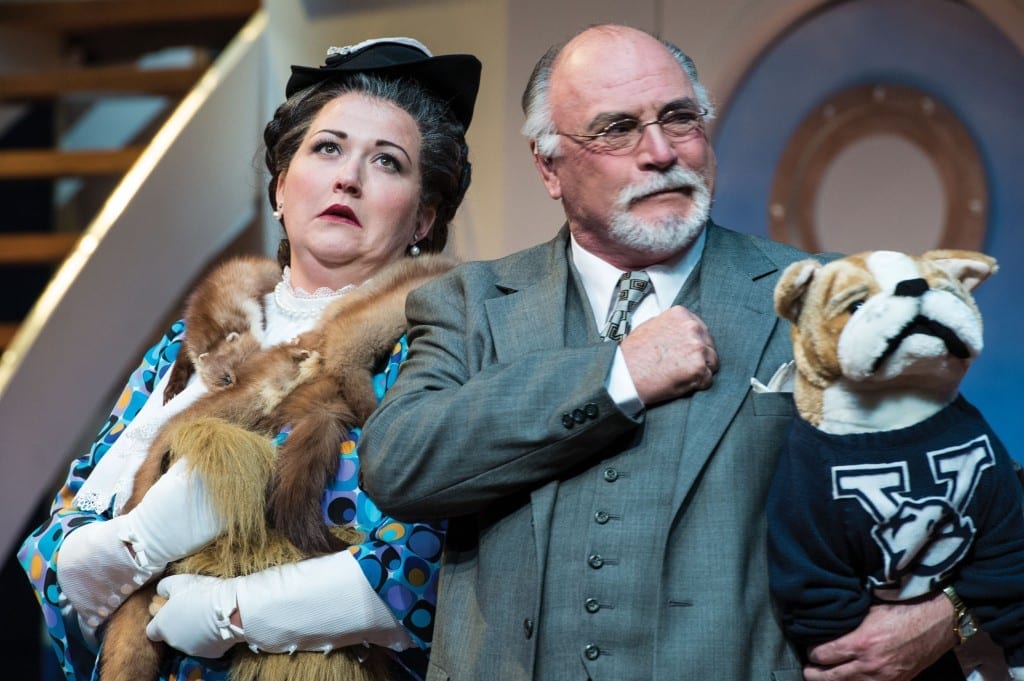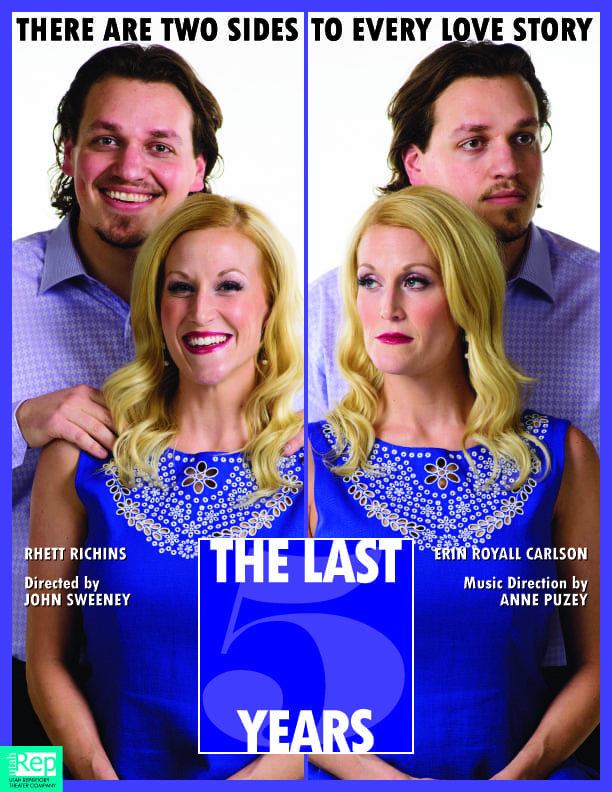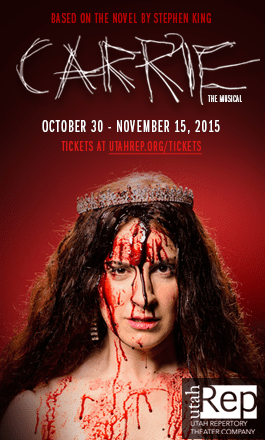Since 2009, Salt Lake Acting Company has given it’s holiday schedule slot to a production for young audiences. Beginning with Go, Dog, Go! based on the book of the same title, this annual event has become a beloved tradition for families, school groups, and those who are young at heart. This year’s offering is Diary of a Worm, a Spider, and a Fly (adapted from the Diary of a Worm series by Doreen Cronin), an uplifting musical adventure providing a “bug’s eye view” to the world. Youth Theatre at U artistic director Penelope Caywood is returning to SLAC to helm her seventh production. In her second interview with UTBA she shares some wisdom about tackling theatre for kids and the importance of finding one’s voice.
Children’s Theatre tends to get a bad rep. What is it about Theatre for Young Audiences that excites you and keeps you coming back?
CAYWOOD: I think Theatre for Young Audiences is where it’s at! I find that people who have directed, designed, and acted in a TYA production are always inspired and energized by the experience. I find the audiences to be the most honest. TYA is a place where imagination and creativity is king. A place where our best stories are shared with each other. In many cases, the stories are happy ones, but there are many wonderful plays and musical for young audiences that ask hard questions and help all of us see the world through someone else’s eyes. There’s a childlike innocence in everyone that gets covered up by influences like societal pressures and cultural norms. TYA can transport us to a place where the inner child is alive and well. That is what excites me. It’s the most important kind of theatre in my opinion.
You’ve directed several very successful productions at SLAC and through Youth Theatre at the U. How do you approach each show? What is your process like?
CAYWOOD: I like to approach the show like a detective – or a dramaturg. I read the material and re-read it and read it again. Then I begin my research. I read the source material if it exists. I make lists. Lists of other books by the same author. Lists of the words I don’t know or words I think the actors or young audience might not know so we cover all the bases. Character lists, song lists, prop lists. I make charts. Who is in what scene when. I color code. I listen to the music in my car a lot. I want to know the show backwards and forwards and be able to sing every part. (I was a straight A student in school.) I always have the show sketched out in my head. I can see it. And then I put it on paper. So-and-so is entering from here and exiting from there, etc. I choreograph the numbers and write it all down. Then I relax and head into the rehearsal room. Then I see what the actors bring to the table. Sometimes – most of the time – they come with incredible ideas and are ready to collaborate once they know what direction I want to go. If they don’t have ideas at first, then I have a game plan we can follow, but I always hope to collaborate and create stuff together.. Musical numbers, I stage with the actors in mind making sure that the story comes first. I like to get shows staged pretty quickly. In professional theatre it’s a necessity. I only have three weeks so I get a week to stage and choreograph a musical. With kids, I still stage quickly because I find that once they are given a structure, they can get creative with confidence. This allows me time to go back over a script and tweak, and change, and play, and add things or cut things to my heart’s delight.
What do you think the biggest challenge of producing a youth show is? How do you face said challenge?
CAYWOOD: Some of the challenges are not directly mine to solve. I think the producers have a challenge in picking the shows – shows that match the mission of the theatre, the audience it’s serving, and that says something that needs to be shared.
Sometimes I have run across actors that may think that TYA is easier that acting in another type of show. That’s not true. Bringing a well-known story to life is a lot of pressure. Making animals or insects honest and relatable, working in and around costume pieces, cramming just as much music and choreography that would normally be in a 2 hour production into a 1 hour show is challenging. I always hope to meet this challenge by casting well. I’ve been incredibly lucky over the years to work with incredibly giving people who are just as excited to share their talents with and for young people as I am.
Who or what are your biggest artistic influences?
CAYWOOD: This is a hard question – mostly because my influences change all the time. My mother is a musician and a educator so she is probably the biggest influencer. From a young age I loved seeing theatre and dance in and out of town and I still do. As a young performer in my teens and early college years, I worked with a man named Doug Vasquez who was a genius director/choreographer. I find myself doing a lot of things that remind me of him in my work today. I also love watching movies and theatre on film. I’m a avid Youtube watcher and anything from So You Think You Can Dance to Frantic Assembly to a Fred and Ginger classic movie musical to Nederlands Dans Theatre is fair game for inspiration. I do have a habit of keeping lists of ideas I want to use or reuse. So, even in this show, there is an idea I used – that I have been waiting to use – for over a decade, that someone described using in another production in a totally different way. So, I have the memory of an elephant that way. I steal ideas and then twist them around to make something new. I’m a upcycler! I am also fortunate to work with several wonderful theatre practitioners every summer. I think we share the philosophy that we never stop learning and exploring new things. We are lucky to have young people around to try out our ideas. My high school conservatory students are the best lab rats a person could have. They are consistently saying “yes” to all my ideas and often take my work and explode it out in miraculous ways. There is inspiration every where.
SLAC is a big supporter of Arts in the schools and Diary will be seen by thirteen Title 1 elementary school as well as partnering with Voices for Utah Children for a special performance. What does arts advocacy mean to you?
CAYWOOD: Advocacy is key and at it’s core, advocacy is simple. Sharing a moving story about the impact of theatre on a child’s life is easy. Developing relationships with decision makers is a bit harder – but not impossible. In the arts education world we have facts and figures on how the arts fosters creativity and innovative thinking; how it improves student achievement in other disciplines; how the arts can advance problem-solving and cognitive skills and enhance cultural understanding. No one can deny this. By sharing your support of productions or of theatre companies, taking a friend to see a show and, keeping up to date on articles about the arts and their impact on young people, you can become a powerful advocate. I’m fortunate enough to sit on the board of the Utah Cultural Alliance, an organization that is is a powerful advocate for the arts, humanities, and culture in Utah. We even have an advocacy blog and all sorts of resources for individuals and organizations. http://www.utahculturalalliance
What makes Youth Theatre at the U the successful program it is?
CAYWOOD: Well, I feel very lucky to say that each year Youth Theatre engages hundreds of young people in our after-school programs and summer camps, we partner with over 50 classrooms in Salt Lake City each year, we entertain thousands of children in our school matinees, and provide professional development for teachers across the state. Although we have a lot of things going on, we do try to keep our operations small. I want to feel connected to all the students and their families. I want our fabulous faculty to feel supported. I want to provide programs that positively impact the community in which Youth Theatre resides. I love being able to make decisions based on what interests our students and how they want to be challenged. I may be the director of this program, but I heavily rely on the teen conservatory students, the 3rd graders at the local school, and the young actors in the current production to help me drive the program to it’s next destination.
Whose work would you recommend developing artists to study?
CAYWOOD: First, let me say that Utah has a very generous community of theatre artists. If a developing artist wants to see how it’s done, then go to a show, email the artistic director or executive producer, and ask how you can get involved. Maybe you can sit in on a rehearsal. Maybe you can meet with the actors after the show. Network. Network. Network.
I would also say that if you want to be a performer then you need to perform. Take an acting class. Audition for that show. Get a singing teacher. Take a dance class or some other type of movement. The voice and the body are the actors tools and they need to get a consistent workout.
None of the above really answers the question as to who to study. This for me changes constantly because I continue to learn about new theatre companies and new techniques, and then I see a cool video on Youtube so I buy a book about that cool thing I saw and then the next thing comes along. Maybe I’m a little ADD.
I’m a huge fan of devised physical theatre, so I love Frantic Assembly (London). They have a great book about devising.
Windmill Theatre Company in Australia fascinates me. Their production values are insane and they are so creative and out-of-the-box.
What is your dream project? Who would you like to collaborate with?
CAYWOOD: I have lots of dream projects!
- I would love to have my own theatre for Youth Theatre productions. Negotiating for space and paying rental fees is very cost prohibitive for Youth Theatre. It would certainly be a dream to have a space to call our own.
- I would love for other professional theatre companies in our state to produce a TYA work and be invited to direct, choreograph, or play in some other way.
- I would love to travel to work with the National Youth Theatre in the UK or the Scottish Youth Theatre or Australian Theatre for Young People. They produce a lot of work. Original work. And I would love to be a fly on the wall to see their processes.
Do you have a favorite line, character, or moment in Diary?
CAYWOOD: I think my favorite moment in the show is a part I call “Dragnet”. It takes place in the classroom and it’s show and tell time. The kids in the class … I mean, insects in the class, tell a story about how they solved a problem together. What I love about this moment is that you see the actors playing pretend using the things they have in the room and providing their own sound effects throughout the action. It’s just like what you might see at recess. It really is a moment where the ensemble is highlighted.
What would you like more of in the world (theatre scene and beyond)?
CAYWOOD: Hmmm … besides more disco balls and glitter …
- I would like to see more ‘adult’ playwrights writing for children and youth that have primarily youth characters and more than 3 or 4 characters.
- I would like to see more theatre in the elementary schools in our state. Of all the art forms drama is the most under-represented in schools and I think the most easily incorporated. Classroom teachers need more training in this art form and more organizations need to hire drama teaching artists that are trained to do outreach.
- I would like people to think of children and young people when they make big decisions that might impact their futures. It’s been very interesting to listen to them, in classrooms and at youth theatre, process our current political climate. They know so much. They hear everything. They often make more sense than the adults in the room.
- I wish it were easier to share ideas and work together cross-culturally. I find that there are so many hoops to jump and red tape to cut even when trying to do a project with young people from different areas in our own state. Creating together shouldn’t be made difficult.
What is next for you?
CAYWOOD: I start directing STINKY CHEESE MAN AND OTHER FAIRLY STUPID TALES for Youth Theatre. This show goes up in March at Kingsbury Hall and is very funny. I’m also taking Youth Theatre’s teen ensemble to California to compete in the Musical Theatre Competition of America. We won our division with an original musical last year which was really exciting.






